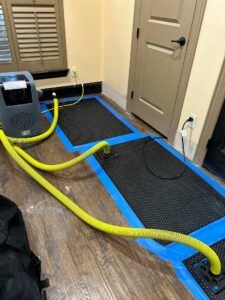Blogs
What steps should I take immediately after discovering water damage?

So, you’ve just stumbled upon some water damage in your home, huh? Don’t panic; I’ve got your back! Discovering water damage can be stressful, but taking swift action is key to minimizing the mess and getting things back to normal. In this blog post, Intensa Dry walk through the essential steps you should take right off the bat to tackle the situation like a pro. From assessing the damage to ensuring safety and reaching out to the right folks for help, we’ve got you covered. So, let’s dive in and get your home back on track!
Assessing the Source and Type of Water

The source and type of water involved in the damage play a significant role in determining the appropriate response. Water damage can stem from various sources, including leaks from plumbing fixtures, overflowing appliances, or natural disasters such as floods. Additionally, water can be categorized into three types: clean water, gray water, and black water. Clean water, such as that from a broken pipe, poses the least risk to health, while gray water, containing some contaminants from sources like washing machines or dishwashers, requires caution. Black water, which includes sewage and floodwater, presents significant health hazards and requires immediate professional intervention.
Assessing the source and type of water is crucial in determining the appropriate cleanup and restoration procedures. Intensa Dry’s trained professionals meticulously analyze whether the water is clean, contaminated, or toxic, as well as its origin, such as from burst pipes, sewage backup, or natural disasters. Understanding these factors allows for tailored strategies, ensuring thorough disinfection and preventing further damage or health hazards. With this detailed assessment, Intensa Dry effectively addresses water damage, restoring affected properties to their pre-loss condition.
Safety First: Ensure a Safe Environment
Before attempting to address water damage, prioritize safety for yourself and others in the affected area. Turn off the electricity and gas supply to the affected area to reduce the risk of electrical shock or gas leaks. If standing water is present and there is a possibility of electrical appliances or wiring being submerged, refrain from entering the area until it’s deemed safe by a qualified professional. Additionally, wear protective gear such as rubber gloves, boots, and a face mask to minimize exposure to contaminants and pathogens present in the water.
Safety First: Ensuring a safe environment is paramount in every aspect of life. When it comes to water damage cleanup and mitigation services, safety should be the top priority. Professional cleanup teams prioritize safety protocols to protect both occupants and workers. This includes thorough risk assessment, proper handling of contaminated water, and utilizing appropriate safety gear. By adhering to strict safety measures, such as wearing protective clothing and using specialized equipment, these services minimize the risk of accidents or health hazards. Ensuring a safe environment during water damage cleanup not only protects individuals but also promotes efficient and effective restoration processes.
Documenting the Damage
Documenting the extent of the water damage is essential for insurance claims and restoration efforts. Take photographs and videos of the affected areas, including any visible damage to walls, floors, ceilings, and personal belongings. Make detailed notes of the date and time the damage occurred, as well as any relevant details about the source of the water and its characteristics. This documentation will serve as valuable evidence during the claims process and help restoration professionals better understand the scope of the damage.
Documenting the damage is crucial in the aftermath of any disaster. Detailed documentation provides essential information for insurance claims, restoration planning, and future prevention strategies. Photographs, videos, and written descriptions capture the extent of the damage, including structural issues, water infiltration points, and affected belongings. This documentation serves as a reference point throughout the cleanup and restoration process, ensuring that every aspect of the damage is addressed comprehensively and accurately.
Mitigating Further Damage
Once safety measures are in place and the damage has been documented, focus on mitigating further damage to your property. Promptly remove any standing water using a wet vacuum, mop, or sump pump, depending on the volume of water present. Open windows and doors to facilitate air circulation and promote drying, but only if the outdoor air is drier than the indoor air. Utilize fans and dehumidifiers to accelerate the drying process and prevent the growth of mold and mildew. Remove any wet or damaged items from the affected area to prevent them from causing additional harm to surrounding materials.
Mitigating further damage is imperative to prevent escalation of the initial disaster’s impact. Prompt action, such as water extraction, moisture control, and structural stabilization, helps halt deterioration and mold growth. Temporary solutions like board-ups or tarping shield properties from additional harm. By swiftly addressing vulnerabilities, mitigation services mitigate secondary damage risks, preserving property value and reducing restoration costs. Partnering with reconstruction services ensures a seamless transition from mitigation to restoration, ensuring a comprehensive approach to safeguarding and restoring properties.
Contacting Your Insurance Provider
Inform your insurance provider of the water damage as soon as possible to initiate the claims process. Provide them with the documentation and evidence you’ve collected, including photographs, videos, and written notes. Be prepared to answer questions about the cause of the damage, the extent of the affected areas, and any steps you’ve taken to mitigate further damage. Depending on your policy coverage, your insurance provider may arrange for an adjuster to assess the damage in person or provide guidance on hiring professional restoration services. Contacting your insurance provider is essential when dealing with water damage. Inform them promptly to initiate the claims process. Provide detailed information and documentation of the damage for a smoother and faster resolution. Your insurance company can offer guidance and support throughout the restoration journey, easing the financial burden.
Seeking Professional Restoration Services
While you may be able to address some aspects of water damage mitigation on your own, certain situations require the expertise of professional restoration services. If the water damage is extensive, if black water is involved, or if mold growth is present, it’s advisable to seek assistance from certified restoration professionals. These experts have the necessary training, equipment, and experience to safely and effectively mitigate water damage, restore affected areas, and prevent future issues such as mold infestation or structural damage.
Seeking professional restoration services is paramount when dealing with water damage. The first step is to prioritize safety by shutting off electricity and gas, then assessing the extent of the damage. Contacting a reputable restoration company immediately is crucial. Professionals assess the situation, devise a comprehensive restoration plan, and execute it efficiently. They utilize specialized equipment to extract water, dry affected areas, and mitigate further damage. By entrusting the task to experts, homeowners ensure a swift and thorough restoration process, minimizing property loss and ensuring a safe environment.
Preventing Mold Growth
One of the most significant risks associated with water damage is the growth of mold and mildew, which can begin to develop within 24 to 48 hours of exposure to moisture. To prevent mold growth, thoroughly dry all affected areas as soon as possible. Use fans, dehumidifiers, and proper ventilation to reduce humidity levels and promote drying. Discard any materials that cannot be thoroughly dried, such as carpet padding, insulation, and upholstered furniture. Additionally, consider applying mold inhibitors or antimicrobial treatments to surfaces to discourage mold growth.
Preventing mold growth is critical after water damage. Swiftly drying affected areas within 24-48 hours and reducing humidity levels below 60% are key steps. Proper ventilation, dehumidification, and using mold inhibitors can help inhibit mold growth. Additionally, removing damaged materials that cannot be thoroughly dried is necessary. Consistent monitoring and prompt action are vital to prevent mold from proliferating, safeguarding both property and health.
Restoring Damaged Materials
Once the affected areas are thoroughly dried and sanitized, assess the extent of damage to building materials and personal belongings. Depending on the severity of the damage, some materials may need to be repaired or replaced entirely. Structural elements such as drywall, insulation, and flooring may require professional repair or replacement to ensure the safety and integrity of your property. Salvageable personal belongings should be cleaned, disinfected, and dried thoroughly before returning them to the affected area.
Restoring damaged materials after water damage involves a meticulous process to salvage as much as possible. Professionals assess the extent of damage, categorizing materials as salvageable or unsalvageable. Salvageable items undergo thorough cleaning, drying, and disinfection to mitigate mold and microbial growth. Advanced techniques like dry cleaning, wet cleaning, and specialized restoration equipment are utilized. For severe damage, reconstruction may be necessary. Partnering with experienced restoration services ensures comprehensive restoration, returning properties to their pre-damage condition efficiently and effectively.
Implementing Preventative Measures
After addressing the immediate aftermath of water damage, take proactive measures to prevent future incidents. Regularly inspect plumbing fixtures, appliances, and roofing for signs of leaks or deterioration, and address any issues promptly. Consider installing water detection devices or automatic shut-off valves to alert you to potential leaks and minimize water damage. Additionally, review your insurance policy coverage and consider supplementing it with additional coverage options, such as flood insurance, to protect against unexpected water-related disasters.
- Regular inspection of plumbing systems, roofs, and foundations
- Installation of sump pumps and backflow preventers
- Ensuring proper drainage around the property
- Sealing cracks and gaps in walls, windows, and doors
- Applying waterproof coatings to vulnerable surfaces
- Proper insulation to prevent condensation
- Prompt repair of leaks and drips
- Installing moisture sensors and alarms for early detection
- Educating occupants on water damage prevention and response protocols
- Establishing an emergency plan for swift action in case of water-related incidents.
FAQs
Is water damage immediate?
Does Water Damage Happen Immediately? Water damage happens quickly, usually within 24 hours. If you notice any signs of water damage, it normally isn’t something you can fix on your own.
How long does a water leak take to dry out?
Generally, it can take anywhere from as little as a few days to as long as seven or eight weeks to fully dry a house after a burst pipe incident. Here are some key factors that can influence the drying time: Firstly, the more water that has entered your home, the longer it will take to dry.
Will water damage go away on its own?
The answer to, “Can water damage fix itself?” is no, unfortunately. If you don’t take action in the moment to minimize the damage, it can last longer and get worse. How long it takes to dry out your home really depends on how quickly you can get rid of all traces of moisture.
What happens if water gets in your walls?
Warping and peeling paint or wallpaper are typical signs of water damage to walls. Drywall and wet sheetrock are weaker and likely to break. The house’s structural integrity gradually deteriorates. It is extremely risky to ignore wall deterioration since they can eventually collapse.
Does water damage smell go away?
Once you’ve taken care of the source of your water damage, prevented the spread of mold and mildew and thoroughly cleaned your carpets, your home should smell fresh and free of foul odors.
Conclusion
In conclusion, discovering water damage can be a nerve-wracking experience, but by acting quickly and methodically, you can mitigate the damage and begin the restoration process effectively. Remember to prioritize safety, document the damage, and seek professional assistance when needed. By taking proactive measures to prevent future incidents and staying informed about your insurance coverage, you can safeguard your home against water-related disasters. With patience, perseverance, and the right support, you’ll be well on your way to restoring your home to its pre-damaged condition and enjoying peace of mind once again. Stay proactive, stay safe, and stay dry!

